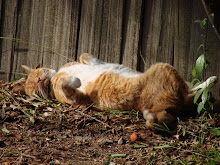I'm trying to figure out the best way to calculate the carbon offset values for all the plants we plant every year at our park. We typically plant between 10,000 and 15,000 coastal sage scrub plants (California sagebrush, purple sage, buckwheat, etc.) into degraded annual grassland. Our average acreage per year is pretty small, between 2 and 3 acres I would estimate. The park service is climate change obsessed these days and one of its obsessions is getting all its parks to be climate friendly (I say, "Howdy climate! How you doin?"). One of the goals of climate friendliness is to get to zero net carbon gain per park by some absurd year like 2016 (right around the corner people, right around the corner...).
So I thought I would try to do my part by coming up with some back of the envelope calculation for the carbon sequestration value of all of these lovely little plants that I plant each year. The complicated part is that it turns out that it is pretty darn tricky and somewhat controversial to calculate these types of values. Since people are going to pay for carbon offsets in many areas of the world (including ours) scientists and policy makers want these carbon sequestration estimates to be rigorous and not just b.s. Which is all fine and good except that all of the fully developed models are based on TREES (How many times do I have to tell you people that I don't live in a forest, SHRUBLAND I tell you, SHRUBLAND).
So anyway, I'm going to sit in my office for a few hours over the next couple of weeks and try to figure this all out or at least take a good stab at it without actually going into the field with a gas exchange analyzer. Wish me luck, and if you have any genius ideas (Sarah Otterstrom, I know you do this kind of thing for a living...), let me know. Right now what I have is some published dry weight data for coastal sage scrub and annual grasslands, some published soil respiration rates for coastal sage scrub and annual grassland, and a bunch of data on number of plants of what type that I have planted. I could also actually measure plants of different ages in the field since I know when I planted all my plants.
I know this is really exciting for all you non-scientists out there but I just had to share.









